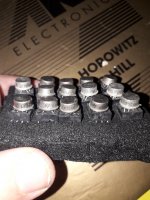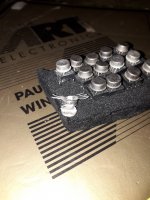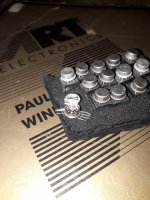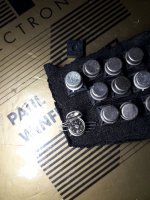Woops...LM4562Is there any documentation for the claimed popcorn noise...I've been using the LM4652/LME49720 for years and have never had any issues.
Mike
It's even on the TI site:
https://e2e.ti.com/support/audio-group/audio/f/audio-forum/725471/lme49720-popcorn-noise
You also get lots of hits on this site when you search for LM4562 popcorn, one example is https://www.diyaudio.com/community/threads/opa2134-stability.368323/post-6550199
https://e2e.ti.com/support/audio-group/audio/f/audio-forum/725471/lme49720-popcorn-noise
You also get lots of hits on this site when you search for LM4562 popcorn, one example is https://www.diyaudio.com/community/threads/opa2134-stability.368323/post-6550199
Last edited:
OPA2132 sounds better than 2134 if driving difficul loads like headphones.It's audible.Also measures better, one order of magnitude better than opa2134 .Look at the thd graphs.In most cases yes unless DC offset is important to the design.
Now that I look at the datasheet, opa2132 has different part gradings, the PA version has the same DC offset as OPA2134, the non-P version is the tighter DC offset spec and higher prices
Thanks to the OP and all the others who gavd me real hopes of giving these little guys a new life! I just desoldered them from a 1 million euros old MRI scan controller board.They didn't even get warm during the desoldering process...
Attachments
You might already know this but be very careful where you buy these audio op amps. The "usual" online sources are often selling remarked fakes such as LM358 remarked with every possible part number you can imagine. I was a bit shocked but even TL071/72/81/82 were fake.
Yeah I see that too in the graphs, so more reasons why the higher costing.OPA2132 sounds better than 2134 if driving difficult loads like headphones. It's audible. Also measures better, one order of magnitude better than opa2134 .Look at the thd graphs.
I'd have to say your ears are the finest detecting the differences between 0.00009% and 0.00015% THD into 600ohm 🙂
Funny how they brand the OPAx134 as "SoundsPlus" and not OPAx132 which performs better.
Same short circuit current specs I see.
Figure 1. in OPAx134 shows some details vs figure 11, in OPAx132
Figure 1. in OPAx134 shows some details vs figure 11, in OPAx132
Just make a 5...6x headphones amp and roll opa2132 and opa2134...I can hear up to 13800...14000hz...I bet you can hear the difference if your hearing is no worse than mine.I always use the inverting topology for headphones and i can hear the difference even with very low common mode distortions.
The TLE2072 and TLE2074 are part of TI's Excalibur series of opamps, with improved specs compared to the original TL07X series - worth a look...
I always buy audio grade semiconductors from RS comp. So chances of getting fake opamps are zero.You might already know this but be very careful where you buy these audio op amps. The "usual" online sources are often selling remarked fakes such as LM358 remarked with every possible part number you can imagine. I was a bit shocked but even TL071/72/81/82 were fake.
That's true. I'm sure there is some differences in performance, but good news is i'm not going to use these opamps for headphones ;-)Funny how they brand the OPAx134 as "SoundsPlus" and not OPAx132 which performs better.
I heard that they have stability issues if not implemented carefully. On the other hand opa2134 almost bulletproof, i mean not as sensitive as TLE series. I don't know why but despite their so called poor performance i like tl07x series very much.The TLE2072 and TLE2074 are part of TI's Excalibur series of opamps, with improved specs compared to the original TL07X series - worth a look...
Best Regards
TI has released a new version of the TL07x amplifier series that seems to be a significant improvement in many parameters, called the TL07xH series. It is a CMOS amplifier, and offers higher supply voltages, better slew rate, almost 30dB lower distortion, and better output drive at the cost of higher voltage noise, especially at lower frequencies. It's in many ways unrelated to the original TL07x series, but I think TI chose to brand it as a TL072 variant due to the popularity of the old series and the relative interchangeability of the new part in circuits designed for the old part.
I have not used them, but where cost is important, they seem to be a good choice. Also note that like many of the new high performance amplifiers offered over the past several decades, PDIP packages are not available. You need to use adapter PCBs if this is a requirement.
https://www.ti.com/lit/gpn/tl072h
I have not used them, but where cost is important, they seem to be a good choice. Also note that like many of the new high performance amplifiers offered over the past several decades, PDIP packages are not available. You need to use adapter PCBs if this is a requirement.
https://www.ti.com/lit/gpn/tl072h
They state it on the TI web site. The last line of the Product Details section says "architecture CMOS" https://www.ti.com/product/TL072HHow do you know that the TL07xH series uses MOSFETs instead of JFETs? It does explain why the 1/f noise is so much worse than for the original TL07x series.
Not sure either why they are being mysterious, but the output stage they have now is no slouch - 26mA short circuit current for the H version, whereas the originals would barely push 10V into 2kΩ - short circuit current was never specified for the old parts because it's probably only a handful of mA. CMOS seems to make lots of sense there. And, if you look at the ordering details, the TL072HIDR (in SO-8 package) is 8.5 cents each in 1k quantities. Yikes that's cheap for low distortion gain!
They state it on the TI web site. The last line of the Product Details section says "architecture CMOS" https://www.ti.com/product/TL072H
Not sure either why they are being mysterious
It indeed says CMOS, and right next to it they show a schematic consisting of JFETs and bipolar transistors. When you read the datasheet very carefully, that schematic turns out to be only for TL072, not TL072H.
I think "being mysterious" is putting it mildly. They are trying to mislead their customers while making sure they can't get sued.
Somewhere on the https://www.diyaudio.com/community/...ormance-cmos-audio-op-amp.335416/post-5732359 thread, johnc124 explained that TI's marketeers used to think that no one would buy a CMOS audio op-amp. They originally described the OPA1656 as a FET op-amp for that reason, which is of course correct, as MOSFETs are FETs.
The maximum output current for the original TL07x series is somewhere in the 25 mA to 30 mA range, looking at graph 6-45 of https://www.ti.com/lit/ds/symlink/tl072.pdf and ignoring the 100 ohm data.
Last edited:
Hmmm. I never had trouble going by the 1978 data for voltage into load resistance, fig 9.short circuit current was never specified for the old parts because it's probably only a handful of mA.
Except 0V in 100 Ohms is just wrong-- some draftsperson thought the graph had to go to the corner, not thinking-out the log scale. At reasonable loads 200r and up it fits with, not a current limit, but dumb resistance. Slightly higher than the 192r explicitly given on the schematic. As always you prefer to load 10X high, 2k, but it 'works' in hundreds of Ohms.
- Home
- Design & Build
- Parts
- Cheap JFET input op-amp




